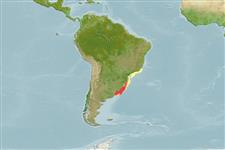Common names from other countries
Environment: milieu / climate zone / depth range / distribution range
Ökologie
seewasser demersal. Subtropical; 9°S - 37°S
Southwest Atlantic: southern Brazil to southern Argentina.
Size / Gewicht / Alter
Maturity: Lm ? range ? - ? cm
Max length : 60.0 cm TL Männchen/unbestimmt; (Ref. ); common length : 40.0 cm TL Männchen/unbestimmt; (Ref. 6077)
Rückenflossenstacheln (insgesamt) : 5 - 6; Rückenflossenweichstrahlen (insgesamt) : 33; Afterflossenstacheln: 3; Afterflossenweichstrahlen: 33 - 41; Wirbelzahl: 27. First dorsal fin composed of several short spines preceded by an anteriorly directed spine usually completely embedded under skin. Two detached anal spines anterior to soft anal fin. Lateral line curved and undulated, with more or less 10 branches anteriorly and fairly straight posteriorly (Ref. 27363). A black patch on the opercle is a conspicuous character of this species, thus the name signata (Ref. 3157).
Maximum length assumed to be 1.5 * 40 = 60 cm TL (RF).
Life cycle and mating behavior
Maturities | Fortpflanzung | Spawnings | Egg(s) | Fecundities | Larven
Robins, C.R., R.M. Bailey, C.E. Bond, J.R. Brooker, E.A. Lachner, R.N. Lea and W.B. Scott, 1991. World fishes important to North Americans. Exclusive of species from the continental waters of the United States and Canada. Am. Fish. Soc. Spec. Publ. (21):243 p. (Ref. 4537)
IUCN Rote Liste Status (Ref. 130435)
CITES (Ref. 128078)
Not Evaluated
Bedrohung für Menschen
Harmless
Nutzung durch Menschen
Fischereien: weniger kommerziell
Tools
Zusatzinformationen
Download XML
Internet Quellen
Estimates based on models
Preferred temperature (Ref.
115969): 11.3 - 22, mean 19.3 (based on 75 cells).
Phylogenetic diversity index (Ref.
82804): PD
50 = 1.0000 [Uniqueness, from 0.5 = low to 2.0 = high].
Bayesian length-weight: a=0.01047 (0.00482 - 0.02276), b=2.92 (2.74 - 3.10), in cm Total Length, based on LWR estimates for this (Sub)family-body shape (Ref.
93245).
Trophic level (Ref.
69278): 3.4 ±0.45 se; based on food items.
Widerstandsfähigkeit (Ref.
120179): mittel, Verdopplung der Population dauert 1,4 - 4,4 Jahre. (Assuming tm>=2).
Fishing Vulnerability (Ref.
59153): Moderate vulnerability (44 of 100).
Climate Vulnerability (Ref.
125649): High to very high vulnerability (75 of 100).
